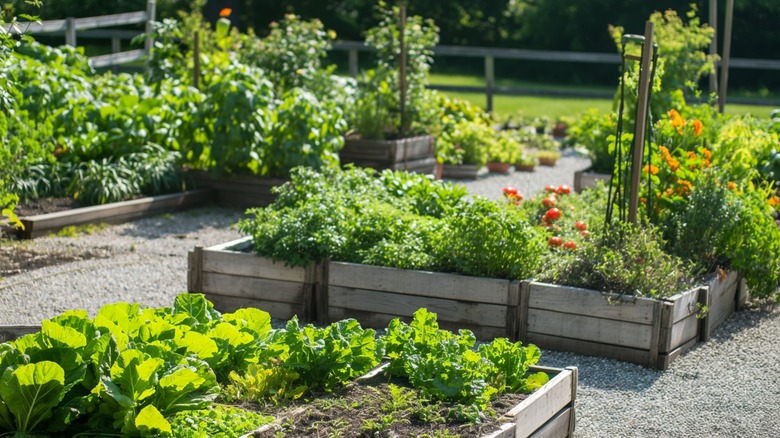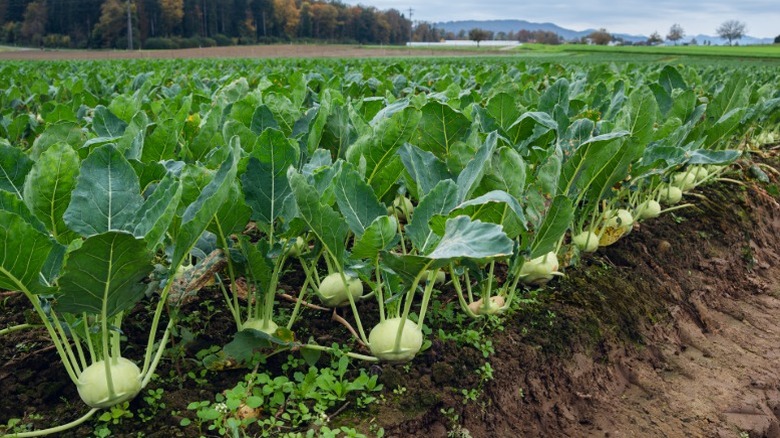The Vegetable You Can Plant In October For A Delicious Winter Harvest
Even though summer's over, there's one cool-season vegetable you didn't know your winter garden needed. You can plant it in October, and by the time frost rolls in, you'll have tender, crisp stems ready to eat. Mildly sweet with a hint of broccoli, it's just as tasty raw as it is cooked. Compact and quick-growing, this winter wonder thrives in small spaces and raised beds. Truly, kohlrabi (Brassica oleracea var. gongylodes) is a garden superstar during the colder months.
Kohlrabi stands out in any garden thanks to its unusual shape. A swollen, round stem rises just above the soil, almost like a turnip lounging on the ground, while broad leaves shoot upward, giving it a slightly otherworldly look. The stems, bulbs, and greens are edible, making this veggie surprisingly versatile, and it will even thrive in shady areas of your garden. You can slice up the crisp bulbs for salads or cook them in soups and stir-fries, and treat the tender leaves like kale or collards for a quick, flavorful sauté.
Kohlrabi has origins in both Europe and Asia, though it was hybridized from wild cabbage in Europe sometime before the 1500s. Its name literally means "cabbage turnip," taken from the German words "Kohl" for cabbage and "Rübe" for turnip, which perfectly captures the look of this unusual vegetable with its swollen base and leafy crown. Gardeners can pick from several colorful cultivars, from pale green to rich purple. 'White Vienna' and 'Purple Vienna' are fast-maturing classics, while 'Gigante' delivers softball-sized bulbs that stay tender, perfect for a longer harvest. With options like these, finding the right kohlrabi for your garden is a breeze, and it will pair perfectly with other crops in your vegetable beds.
Tending to your kohlrabi in your vegetable garden
Kohlrabi does well in full sun or part-shade, and well-draining soil, with consistent moisture to keep bulbs tender. For a winter harvest, sow seeds ¼ to ½ inch deep in early fall, spacing plants 4 to 6 inches apart, in rows 10 to 12 inches apart. In mild regions, planting in early October gives bulbs enough time to form before hard freezes, while colder areas should start a few weeks earlier. If using transplants, set seedlings at the same depth they grew in the pots.
Caring for kohlrabi is straightforward but key for a quality harvest. A thin layer of mulch shields shallow roots and retains moisture. Water consistently, especially during dry spells, to prevent bulbs from becoming tough. Fertilize only if soil tests indicate deficiencies, and follow recommendations to provide balanced nutrients. Watch for common pests, including aphids, flea beetles, and cabbageworms — row covers can protect young plants from damage. Shallow, frequent cultivation keeps weeds in check without disturbing roots. To lower disease risk, avoid planting kohlrabi where other brassicas — such as cabbage, broccoli, or kale — have grown in the previous four years. Do not grow kohlrabi too close to tomatoes, since this pairing can attract pests like hornworms, putting both crops at risk.
Harvest bulbs when they reach 2 to 4 inches in diameter for the sweetest, most tender flavor; larger bulbs can become tough. This is one vegetable you should wait to harvest after a big frost, as the cooler temperatures enhance its flavor and tenderness. Fall-harvested kohlrabi stores well in the refrigerator for two to four weeks, providing fresh, crunchy vegetables throughout winter. Minimal effort yields versatile, nutrient-rich produce and a unique addition to your cold-season garden.

